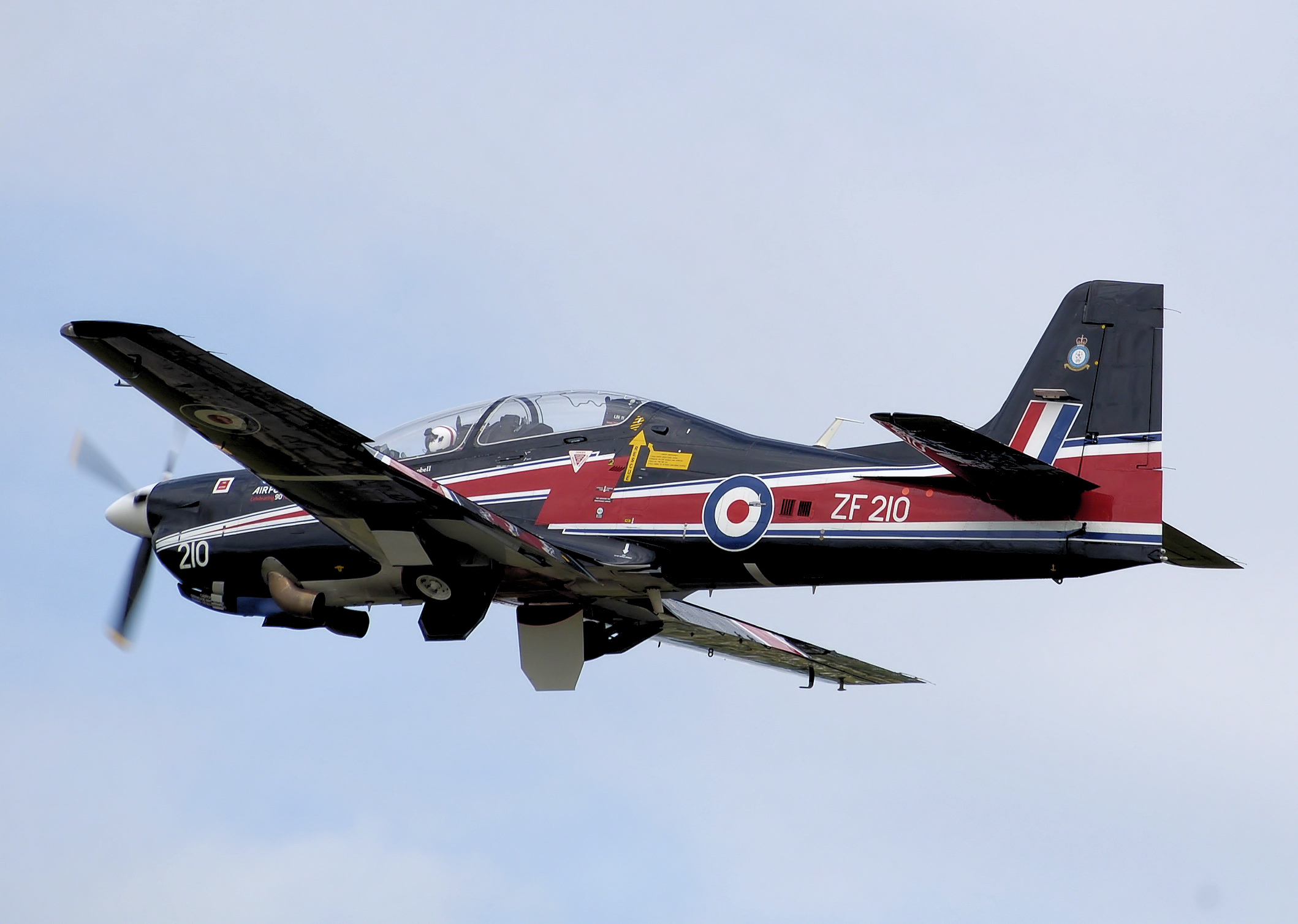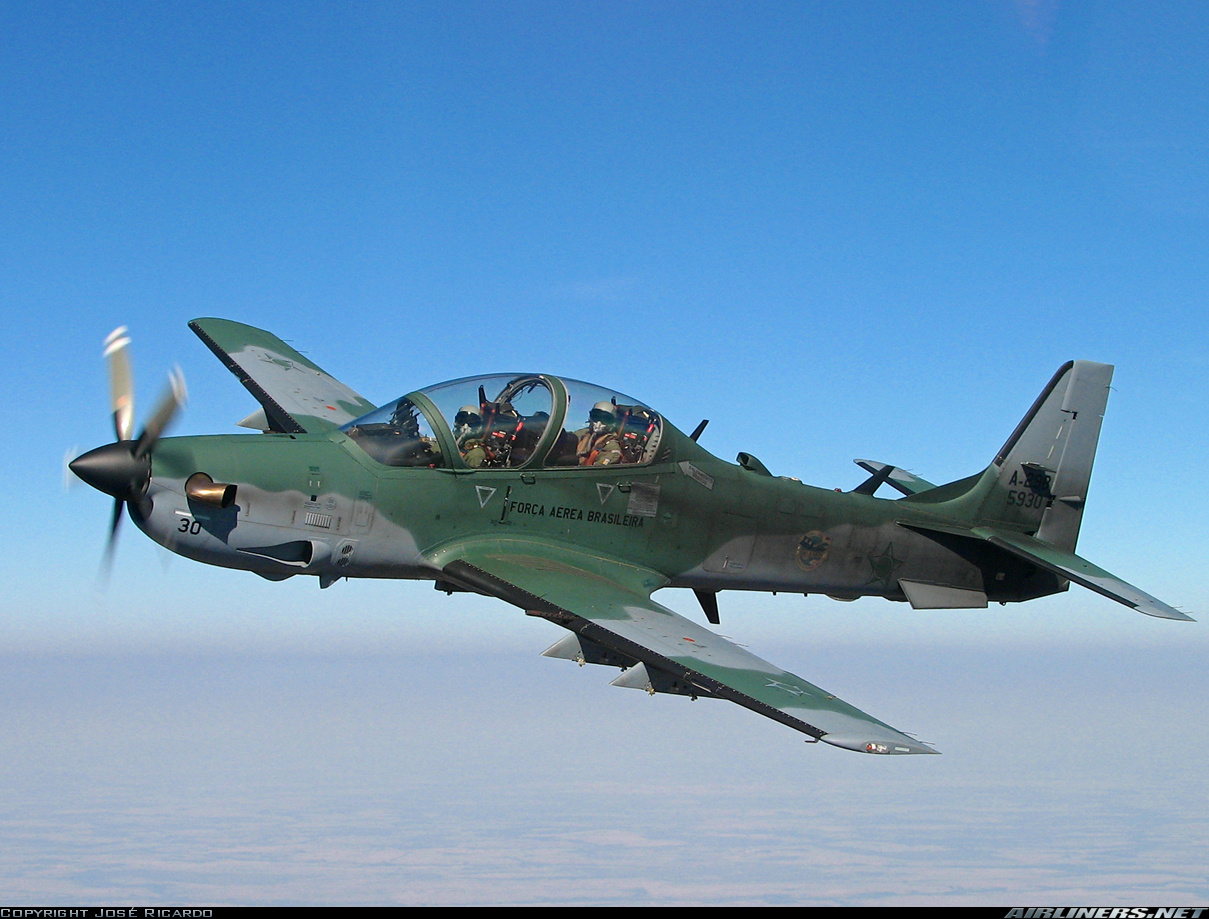Tucano Aircraft - The Embraer EMB 314 Super Tucano, also known as the ALX or A-29, is a Brazilian turboprop light attack aircraft designed and built by Embraer as a development of the Embraer EMB 312 Tucano. The A-29 Super Tucano carries a variety of weapons, including precision munitions, and was designed as an inexpensive system to operate in low-threat environments.
In addition to production in Brazil, Embraer established a production line in the United States with Sierra Nevada Corporation to produce the A-29 for export customers.
Tucano Aircraft

In the mid-1980s, Embraer worked on the Short Tucano, along with a new version called the EMB-312G1 with the same Garrett engine. The EMB-312G1 prototype made its first flight in July 1986. However, the project was abandoned because the Brazilian Air Force was not interested in it. Nevertheless, the lessons learned from the direct combat use of the aircraft in Peru and Venezuela forced Embraer to continue the research. In addition to training, he studied a variant of the attack helicopter called the "Helicopter Killer" or EMB-312H.
Hobby Boss 1/48 Scale Brazilian Emb 312 Tucano
The research was prompted by a failed bid for the US Army's Joint Basic Aviation Training System program. A proof-of-concept prototype first flew in September 1991. The aircraft has a fuselage extension of 1.37 m (4.5 ft) and with the addition of forward and aft cockpit sections to restore the center of gravity and stability, a reinforced airframe, fuselage sealing and an extended nose make the stronger PT6A apply 67R engine (1,424 hp or 1062 kW). In 1993, two new prototypes were created with the PT6A-68A engine (1250 hp).
This EMB-312H prototype first flew on September 9, 1991, and is now on display at the Memorial Aeroespacial Brasileiro in São José dos Campos.
The request for the light attack aircraft was part of the Brazilian government's Amazon Surveillance System project. This aircraft will fly alongside the R-99A and R-99B aircraft in service and will be used to intercept illegal aircraft flights and patrol the Brazilian borders. The ALX project was created by the Brazilian Air Force, which also needed a military trainer to replace the Embraer EMB 326GB Xavante. The new aircraft had to be adapted to the Amazon region (high temperature, humidity and rain; low military risk). The ALX was defined as a long-range and autonomous turboprop aircraft, capable of operating day and night, in all weather conditions and capable of landing at short airports without infrastructure.
In August 1995, the Brazilian Ministry of Aeronautics awarded a $50 million contract to Embraer to develop the ALX. Two EMB-312Hs were upgraded to serve as ALX prototypes. They made their first flights in the new configuration in 1996 and 1997, respectively. The first flight of the ALX series, based on one of the modified prototypes, took place on June 2, 1999. The second prototype was modified to a twin-engine configuration and made its first flight on October 22, 1999. The changes were so significant that the type received a new designation, the EMB-314 Super Tucano.
Raf Tucano T1 Makes Last Public Display
The aircraft differs from the basic training and education aircraft EMB-312 Tucano in several dimensions. It is equipped with a more powerful Pratt & Whitney Canada PT6A-68C engine with a capacity of 1600 hp. has a strong airframe that withstands high g loads and has a service life of 8,000-12,000 hours in working conditions; Reinforced landing gear to handle higher weight and heavy supply loads, up to 1,550 kilograms (3,420 lb); protection of kevlar weapons; two internal, wing-mounted .50 cal. machine guns (200 rounds each);
The ability to carry a variety of munitions on five gun mounts, including Giat NC621 20 mm cannon, Mk 81/82 grenades, MAA-1 Piranha air-to-air missiles (AAMs), BLG-252 and the SBAT-70/19 cluster. bombs, or LAU-68A/G rocket capsules on substations; and has a "glass cockpit" compatible with night vision goggles, adjustable controls and knobs (HOTAS); providing a communication channel; video camera and recorder; built-in mission planning capability; frontal infrared; foam/torch dispenser; missile approach warning receiver systems and radar warning receivers; and zero-zero ejection seats.
The structure is corrosion resistant, and the sided dome has a wind deflector capable of withstanding bird strikes of up to 270 kn (500 km/h; 310 mph).

In 1996, Embraer selected Israeli firm Elbit Systems to provide avionics for the ALX mission. Elbit was selected for this contract by GEC-Marconi and Sextant Avionique. The Israeli company supplies equipment such as mission computers, display screens, as well as navigation and inventory management systems.
A 29 Super Tucano Fleet Reaches 500,000 Flight Hours
On October 13, 2010, the Super Tucano A-29B from July 21, 2005, during full-scale wing and fuselage structural testing by the Aeronautical Systems Division, part of the Aeronautics and Space Administration's Structural Test , exceeded 48,000 hours. . The tests involve a complex system of hydraulics and tables that pressurize the plane's structure, simulating the air pressure from flying at different altitudes. For the damage tolerance analysis program developed by Embraer and the Aeronautics and Space Institute, the simulation continued for another year to complete engine durability testing and crack propagation studies.
The Embraer company has developed a complex of advanced training and support systems called the Training Operation Support System (TOSS) - an integrated computing tool consisting of four systems: computer training, which allows students to repeat the last flight on a computer simulation; an aviation mission planning station that uses three-dimensional (3D) visual effects to operate planned missions and check visibility between aircraft, aircraft and other objects; a mission collection station that uses real-world flight data to replay missions for review and analysis; and flight simulator.
MPS and MDS were enhanced with MAK's 3D visualization solution to support the Air Force's existing data, including GIS, web servers and a plugin for special terrain formats.
In 2012, Boeing Defse, Space & Security was selected to integrate the Joint Direct Attack Munition and Small Bomb into the Super Tucano.
A Portfolio Of Products For The 21st Century
In 2013, Embraer Defense and Security announced that its company OrbiSat was developing a new radar for the Super Tucano.
A Colombian general said an airborne radar would be able to detect ground targets with digital accuracy smaller than a car.
In 2011, the Super Tucano was announced as the winner of the US light aircraft support contract competition over the Hawker Beechcraft AT-6B Texan II.

The contract was canceled in 2012 following an appeal by Hawker Beechcraft after its bid was rejected during the procurement process.
First Batch Of A 29 Super Tucano Aircraft Leave Us For Nigeria
The first four aircraft arrived in Afghanistan in January 2016, and four more aircraft were delivered at the end of 2016. Combat-ready Afghan A-29 pilots completed training at Moody Air Force Base, Ga., and returned to Afghanistan to replace 30 pilots from the 81st Fighter Squadron at Moody Air Force Base. train, take. According to a senior official of the US Department of Defense, a fleet of 20 A-29 aircraft will be built by 2018. Ptagon Super Tucanos in a $427 million deal from Sierra Nevada Corp. and Embraer, with aircraft built at Embraer's facility at Jacksonville International Airport in Jacksonville, Florida.
In 2017, the Afghan Air Force conducted nearly 2,000 airstrikes, almost 40 per week. The AAF hit a record high in October with more than 80 missions per week. Until March 2018, 12 A-29 were in the service of the Armed Forces. On March 22, 2018, the Afghan Air Force deployed a 250 lb (113.4 kg) GBU-58 Paveway II bomb in combat from an A-29 Super Tucano, marking the first time the Afghan military has deployed a weapon with laser guidance against the Taliban. .
In August 2021, during the 2021 Taliban offensive and invasion of Kabul, some Afghan pilots fled the country, taking an unknown number of aircraft with them, including the A-29.
It was initially reported that it was shot down by the Uzbek air defense, the Uzbek prosecutor's office announced in a statement that an Afghan warplane had collided with a MiG-29 of the Uzbek Air Force, and eventually retracted the initial statement. - air collision.
Embraer Emb 312 Tucano
In August 2001, the Brazilian Air Force awarded Embraer a contract for 76 Super Tucano/ALX aircraft with options for 23 more. A total of 99 aircraft were purchased under a contract worth $214.1 million; 66 of these aircraft are two-seat versions of the A-29B. The remaining 33 aircraft are single-seat versions of the A-29 ALX.
Within the Sivam program, one of the main tasks of the planes is the border patrol. On June 3, 2009, two Brazilian Air Force Super Tucanos operated by an Embraer E-99 intercepted a Cessna U206G involved in drug trafficking. On the flight from Bolivia, the Cessna was intercepted in the Alta Floresta d'Oeste area, and after all the procedures were completed, one of the Super Tucanos fired a warning shot with its 12.7 mm guns, after the aircraft followed the Super . Tucanos to Kakoalu Airport. The incident was the first use of powers under the Downed Aircraft Act, which was passed in October 2004 to legally shoot down illegal aircraft. A total of 176 kg of paste based on pure cocaine,
Aircraft tow truck, aircraft universal tow bar, tow bar for aircraft, aircraft power tow bar, diy electric aircraft tow bar, aircraft tow bar, aircraft tow, aircraft tow bar for sale, power tow aircraft tug, aircraft electric tow bar, aircraft tow tug, used aircraft tow bar for sale
0 Comments